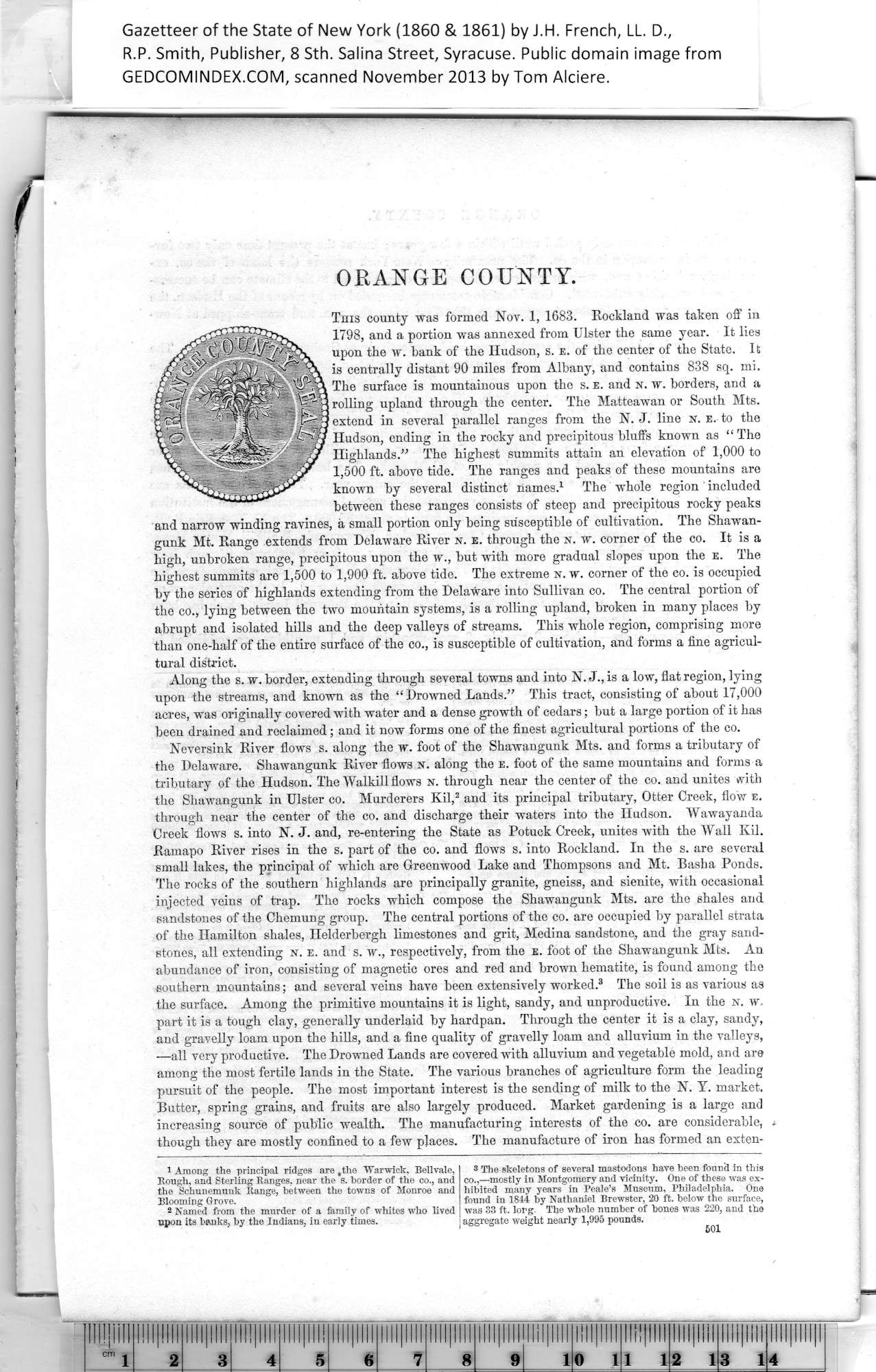|
ORANGE COUNTY.
This county was formed Nov. 1, 1683. Rockland was taken off in
1798, and a portion was annexed from Ulster the same year. It lies
upon the w. bank of the Hudson, s. e. of the center of the State. It
is centrally distant 90 miles from Albany, and contains 838 sq. mi.
The surface is mountainous upon the s. e. and n. w. borders, and a
rolling upland through the center. The Matteawan or South Mts.
extend in several parallel ranges from the N. J. line n. e. to the
Hudson, ending in the rocky and precipitous bluffs known as “ The
Highlands.” The highest summits attain an elevation of 1,000 to
1,500 ft. above tide. The ranges and peaks of these mountains are
known by several distinct names.1 The whole region included
between these ranges consists of steep and precipitous rocky peaks
and narrow winding ravines, a small portion only being susceptible of cultivation. The Shawan-
gunk Mt. Range extends from Delaware River n. e. through the n. tv. corner of the co. It is a
high, unbroken range, precipitous upon the w., but with more gradual slopes upon the e. The
highest summits are 1,500 to 1,900 ft. above tide. The extreme n. w. corner of the co. is occupied
by the series of highlands extending from the Delaware into Sullivan co. The central portion of
the co., lying between the two mountain systems, is a rolling upland, broken in many places by
abrupt and isolated hills and the deep valleys of streams. This whole region, comprising more
than one-half of the entire surface of the co., is susceptible of cultivation, and forms a fine agricul¬
tural district.
Along the s. w. border, extending through several towns and into N. J., is a low, flat region, lying
upon the streams, and known as the “Drowned Lands.” This tract, consisting of about 17,000
acres, was originally covered with water and a dense growth of cedars; but a large portion of it has
been drained and reclaimed; and it now forms one of the finest agricultural portions of the co.
Neversink River flows s. along the w. foot of the Shawangunk Mts. and forms a tributary of
the Delaware. Shawangunk River flows n. along the e. foot of the same mountains and forms a
tributary of the Hudson. The Walkill flows n. through near the center of the co. and unites with
the Shawangunk in Ulster co. Murderers Kil,2 and its principal tributary, Otter Creek, flow e.
through near the center of the co. and discharge their waters into the Hudson. W away an da
Creek flows s. into N. J. and, re-entering the State as Potuck Creek, unites with the Wall Kil.
Ramapo River rises in the s. part of the co. and flows s. into Rockland. In the s. are several
small lakes, the principal of which are Greenwood Lake and Thompsons and Mt. Basha Ponds.
The rocks of the southern highlands are principally granite, gneiss, and sienite, with occasional
injected veins of trap. The rocks which compose the Shawangunk Mts. are the shales and
sandstones of the Chemung group. The central portions of the co. are occupied by parallel strata
of the Hamilton shales, Helderbergh limestones and grit, Medina sandstone, and the gray sand¬
stones, all extending n. e. and s. w., respectively, from the e. foot of the Shawangunk Mts. An
abundance of iron, consisting of magnetic ores and red and brown hematite, is found among the
southern mountains; and several veins have been extensively worked.3 The soil is as various as
the surface. Among the primitive mountains it is light, sandy, and unproductive. In the n. w,
part it is a tough clay, generally underlaid by hardpan. Through the center it is a clay, sandy,
and gravelly loam upon the hills, and a fine quality of gravelly loam and alluvium in the valleys,
—all very productive. The Drowned Lands are covered with alluvium and vegetable mold, and are
among the most fertile lands in the State. The various branches of agriculture form the leading
pursuit of the people. The most important interest is the sending of milk to the N. Y. market.
Butter, spring grains, and fruits are also largely produced. Market gardening is a large and
increasing source of public wealth. The manufacturing interests of the co. are considerable, *
though they are mostly confined to a few places. The manufacture of iron has formed an exten-
|
3 The skeletons of several mastodons have been found in this
co.,—mostly in Montgomery and vicinity. One of these was ex¬
hibited many years in Peale’s Museum, Philadelphia. One
found in 1844 by Nathaniel Brewster, 20 ft. below the surface,
was 33 ft. long. The whole number of bones was 220, and the
I aggregate -weight nearly 1,995 pounds.
1 501 |
1
Among the principal ridges are ,the Warwick, Bellvale,
Rough, and Sterling Ranges, near the s. border of the co., and
the Schunemunk Range, between the towns of Monroe and
Blooming Grove.
2
Named from the murder of a family of whites who lived
3
upon its banks, by the Indians, in early times.
|
